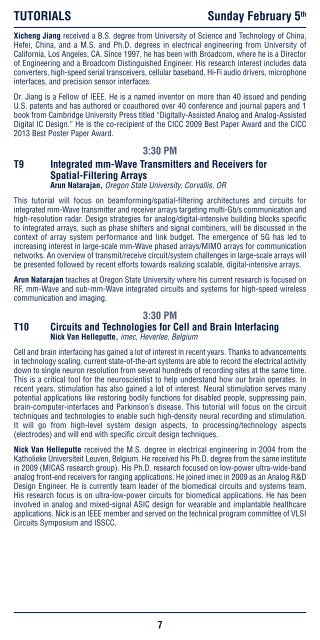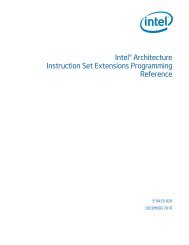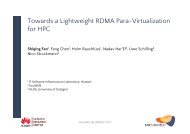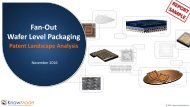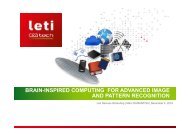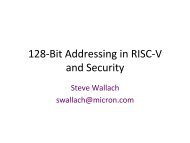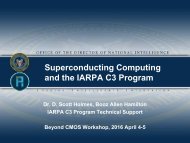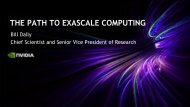PHYSIOLOGICAL-READOUT
ISSCC2017AdvanceProgram
ISSCC2017AdvanceProgram
Create successful ePaper yourself
Turn your PDF publications into a flip-book with our unique Google optimized e-Paper software.
TUTORIALS<br />
Sunday February 5 th<br />
Xicheng Jiang received a B.S. degree from University of Science and Technology of China,<br />
Hefei, China, and a M.S. and Ph.D. degrees in electrical engineering from University of<br />
California, Los Angeles, CA. Since 1997, he has been with Broadcom, where he is a Director<br />
of Engineering and a Broadcom Distinguished Engineer. His research interest includes data<br />
converters, high-speed serial transceivers, cellular baseband, Hi-Fi audio drivers, microphone<br />
interfaces, and precision sensor interfaces.<br />
Dr. Jiang is a Fellow of IEEE. He is a named inventor on more than 40 issued and pending<br />
U.S. patents and has authored or coauthored over 40 conference and journal papers and 1<br />
book from Cambridge University Press titled “Digitally-Assisted Analog and Analog-Assisted<br />
Digital IC Design.” He is the co-recipient of the CICC 2009 Best Paper Award and the CICC<br />
2013 Best Poster Paper Award.<br />
3:30 PM<br />
T9 Integrated mm-Wave Transmitters and Receivers for<br />
Spatial-Filtering Arrays<br />
Arun Natarajan, Oregon State University, Corvallis, OR<br />
This tutorial will focus on beamforming/spatial-filtering architectures and circuits for<br />
integrated mm-Wave transmitter and receiver arrays targeting multi-Gb/s communication and<br />
high-resolution radar. Design strategies for analog/digital-intensive building blocks specific<br />
to integrated arrays, such as phase shifters and signal combiners, will be discussed in the<br />
context of array system performance and link budget. The emergence of 5G has led to<br />
increasing interest in large-scale mm-Wave phased arrays/MIMO arrays for communication<br />
networks. An overview of transmit/receive circuit/system challenges in large-scale arrays will<br />
be presented followed by recent efforts towards realizing scalable, digital-intensive arrays.<br />
Arun Natarajan teaches at Oregon State University where his current research is focused on<br />
RF, mm-Wave and sub-mm-Wave integrated circuits and systems for high-speed wireless<br />
communication and imaging.<br />
3:30 PM<br />
T10 Circuits and Technologies for Cell and Brain Interfacing<br />
Nick Van Helleputte, imec, Heverlee, Belgium<br />
Cell and brain interfacing has gained a lot of interest in recent years. Thanks to advancements<br />
in technology scaling, current state-of-the-art systems are able to record the electrical activity<br />
down to single neuron resolution from several hundreds of recording sites at the same time.<br />
This is a critical tool for the neuroscientist to help understand how our brain operates. In<br />
recent years, stimulation has also gained a lot of interest. Neural stimulation serves many<br />
potential applications like restoring bodily functions for disabled people, suppressing pain,<br />
brain-computer-interfaces and Parkinson’s disease. This tutorial will focus on the circuit<br />
techniques and technologies to enable such high-density neural recording and stimulation.<br />
It will go from high-level system design aspects, to processing/technology aspects<br />
(electrodes) and will end with specific circuit design techniques.<br />
Nick Van Helleputte received the M.S. degree in electrical engineering in 2004 from the<br />
Katholieke Universiteit Leuven, Belgium. He received his Ph.D. degree from the same institute<br />
in 2009 (MICAS research group). His Ph.D. research focused on low-power ultra-wide-band<br />
analog front-end receivers for ranging applications. He joined imec in 2009 as an Analog R&D<br />
Design Engineer. He is currently team leader of the biomedical circuits and systems team.<br />
His research focus is on ultra-low-power circuits for biomedical applications. He has been<br />
involved in analog and mixed-signal ASIC design for wearable and implantable healthcare<br />
applications. Nick is an IEEE member and served on the technical program committee of VLSI<br />
Circuits Symposium and ISSCC.<br />
7


